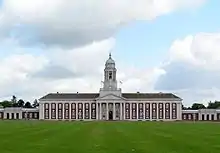James Grey West
Sir James Grey West OBE (1885 – 15 June 1951) was a British architect. Born and trained in Cardiff, Wales, West joined the government Office of Works in 1904, eventually succeeding Sir Richard Allison as chief architect in 1934.[1]

West worked on Bromyard House, the former Ministry of Pensions building in Acton, London (1914–1922), said to be the largest single building in Britain at the time.[2] He designed the hall of Royal Air Force College at Cranwell, Lincolnshire (1929–1933) in the seventeenth-century style of Sir Christopher Wren.[3] West also worked on the Duveen Wing of the National Portrait Gallery (1933), with Allison,[4] and also provided designs for the Royal Courts of Justice, Belfast (1933).[5] As chief architect, he oversaw the building of Thomas Tait's St. Andrew's House in Edinburgh (1935–39).[6] He was knighted in 1936. During the Second World War, West was appointed Director of Post-War Planning, as well as being chief architect of the reorganised Ministry of Works, until his retirement in 1945.[6]
References
- "H M Office of Works (later Ministry of Works and Property Services Agency)". Dictionary of Scottish Architects. Retrieved 17 September 2008.
- "Historic Acton building swaps Canadian WWII troops for west London key workers". Dominion Housing Group. 6 March 2009. Retrieved 17 August 2008.
- "Military Buildings 1914–1945" (PDF). Military Buildings Selection Guide. English Heritage. March 2007. p. 7. Retrieved 17 September 2008.
- "History of the National Portrait Gallery". Retrieved 17 September 2008.
- "Royal Courts of Justice". Archived from the original on 8 December 2008. Retrieved 17 September 2008.
- "James Grey West". Dictionary of Scottish Architects. Retrieved 2008-09-17.